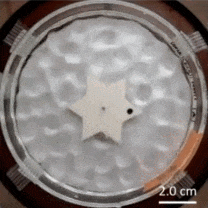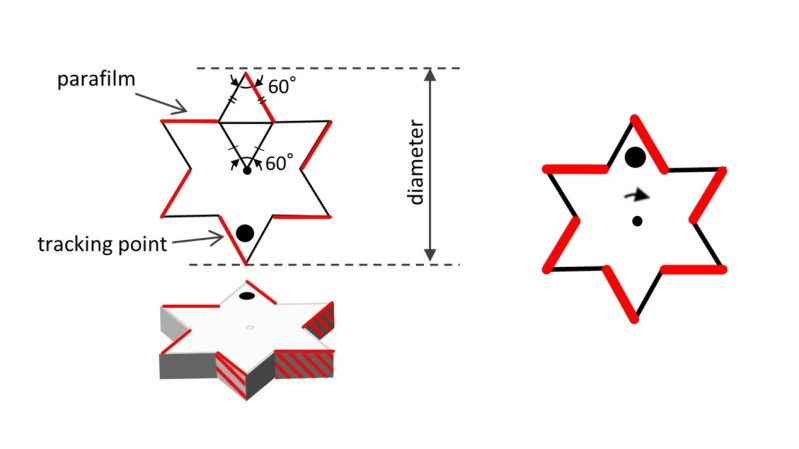Here’s a novel ratchet mechanism developed by researchers that demonstrates how a single object — in this case a gear shaped like a six-pointed star — can rectify the disordered energy of its environment into one-way motion.

The Feynman–Smoluchowski ratchet has alternating surface treatments on the sides of its points, accomplished by applying a thin film layer to create alternating smooth/rough faces. This difference in surface wettability is used to turn agitation of surrounding water into a ratcheting action, or one-way spin.
This kind of mechanism is known as an active Brownian ratchet, but unlike other designs, this one doesn’t depend on the gear having asymmetrical geometry. Instead of an asymmetry in shape, there’s an asymmetry in the gear tooth surface treatments. You may be familiar with the terms hydrophobic and hydrophilic, which come down to a difference in surface wettability. The gear’s teeth having one side of each is what rectifies the chaotic agitation of the surrounding water into a one-way spin. Scaled down far enough, these could conceivably act as energy-harvesting micromotors.
Want more detail? The published paper is here, and if you think you might want to play with this idea yourself there are a few different ways to modify the surface wettability of an object. High voltage discharge (for example from a Tesla coil) can alter surface wettability, and there are off-the-shelf hydrophobic coatings we’ve seen used in art. We’ve even seen an unusual clock that relied on the effect.















Gotta be honest here: Feynman or not, this sure smells like a Maxwell’s Demon.
The big thing about Maxwell’s demon is that it theoretically reduced entropy without doing any work (disregarding the energy required to track all the particles, the fact that this would involve observing the particles and collapsing/modifying their states, and of course disregarding the energy needed to open and close the door).
This ratchet thingy would extract energy from Brownian motion but it wouldn’t reduce its entropy, I think it would end up very slightly slowing the movement in the media (lowering the temperature) which is where the energy required for rotating the gear comes from. But I’m no physicist, I’m interested in other people’s interpretations
I can’t adequately comment on what would happen when the rotor becomes warmer than its surroundings but, based on thermodynamic laws, I would expect that it would cause the rotor to exert an opposing force as it transfers energy back to the surrounding medium.
If it purely cools it down, then you have free energy because you can now harvest the differential between the medium it’s in and the external temperature.
Crooke’s Radiometer
Yeah, except Crookes actually depends on an external radiation source and a temperature differential between the two faces. This magic ratchet thingy doesn’t, apparently.
It’s pedantic but arguable that this constitutes an asymmetry in shape, simply at a different scale.
If you had an arbitrarily large array of these with low enough mass and low-friction bearings, I wonder how much power you could practically get out of it before you hit diminishing returns
It looks like a violation of the second thermodynamics principle. Where is the trick?
No, it is not. It is not about harvesting energy from the thermal Brownian motion as I originally thought. They are actively providing energy to the system. So far so good.
If only the vibrating element need to power the thingy was powered by nothing…
Shame there’s no video that I can find anywhere. Looks like it would be a really stunning spectacle.
Not sure why anyone is freaking out here, we have many many ways of making one way rachets, I have one on my wrist right now in a cheap automatic movement watch.
It’s interesting that it’s achieved with differential surface coatings but that doesn’t somehow make it challenge the laws of nature. If it helps just remember that it’s not really symmetrical once you look at the surface coating it just is to our dumb human eyes (not even to our finger tips would it seem symmetrical).
There’s video of it working in the supplementary material material at the end of the paper; I’m not sure I’d descriibe it as a ‘stunning spectacle’ (even at 5x speed, which the video is), but it’s pretty cool.
I just keep thinking “Infinite Improbability Drive” and expecting a cup of tea to be involved.